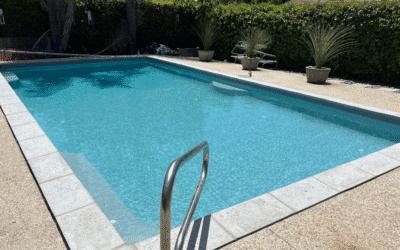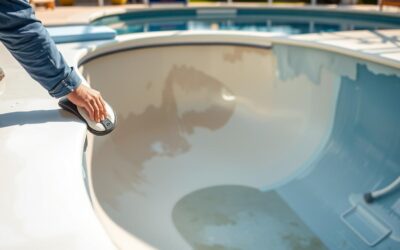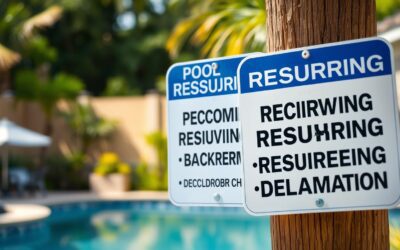Surface stains and discoloration are common issues in both residential and commercial pools—especially as they age. Whether it’s a few unsightly patches or widespread fading, these marks don’t just affect your pool’s appearance—they often signal deeper maintenance challenges.
This blog breaks down the most common causes of staining, how to recognize them, and what to do when cleaning no longer works.
Understanding the Causes of Pool Staining
Staining can appear as blotchy patches, scale buildup, scum lines, or discoloration that doesn’t brush away. Some stains are cosmetic, while others are tied to water chemistry or surface degradation. Below are the key culprits:
1. Organic Stains
Organic matter includes leaves, tree berries, flower petals, and acorns that release tannins and other compounds as they decompose—leading to brown, green, or reddish stains.
Algae growth, when left untreated, can also cause discoloration. Green or yellow stains are common with mild algae buildup, while black algae is particularly stubborn. This spore-forming growth embeds into porous surfaces and can persist unless properly treated.
2. Metal Stains
Metals such as iron, copper, and manganese can oxidize in pool water, leading to distinct stains:
- Iron – Rust-colored or orange-brown stains
- Copper – Blue-green or even purple discoloration, often from older heaters or plumbing
- Manganese – Dark brown or black spots, frequently introduced through groundwater or fertilizers
Metal stains may develop gradually and are often hard to remove without specialized treatments or water correction.
3. Scale Buildup
Calcium carbonate deposits—commonly known as scale—appear as white or tan chalky buildup. These rough patches are typically found along tile lines and other water-exposed surfaces.
Scale is usually caused by high calcium hardness, elevated pH, or total alkalinity, especially in hot climates like Southern California. If water becomes oversaturated with minerals, scale forms quickly and can damage both surfaces and equipment.
4. Other Contributing Factors
In addition to the categories above, several issues can accelerate staining and surface damage:
- Oil and debris accumulation: Body oils, sunscreen, and dirt can form scum lines
- High total dissolved solids (TDS): Oversaturation can make the water difficult to balance and disinfect
- Aging equipment: Worn-out heaters or filters can break down internally, releasing metals or contaminants into the water
Older plaster surfaces are especially prone to these issues, as they become more porous over time and harder to maintain.
What Can You Do About Staining?
Some stains can be treated with chemical cleaners or brushing, but recurring issues typically signal underlying problems. Here are practical steps you can take:
1. Maintain Proper Water Balance
Take a water sample to a local pool store (most offer free testing) and adjust pH, alkalinity, and hardness as needed to keep water balanced and stain-resistant.
2. Clean Regularly
Remove debris quickly, brush surfaces, and vacuum the pool floor. If you don’t use a pool service, consider investing in a vacuum system and use a test kit weekly during peak season.
3. Use Clarifiers and Metal Removers
Ask a pool professional or pool supply store about products that help bind and remove excess metals. These are particularly helpful if you use well water or live in an area with high mineral content.
4. Refill or Recycle Water When Needed
High TDS levels can make water difficult to treat. In some cases, draining and refilling (or using reverse osmosis treatment) is the best option for a fresh start.
5. Evaluate the Pool Surface
As pools age, especially plaster ones, the surface becomes more porous and prone to holding stains. A rough, pitted finish may indicate that it’s time to resurface.
Why Resurfacing Offers a Long-Term Solution
If your pool stains keep returning, the issue might not be your water—it may be your surface. Resurfacing creates a smooth, non-porous finish that helps:
- Resist future staining from metals, algae, and debris
- Improve water balance and reduce chemical usage
- Make the pool easier to clean and maintain
At Aqua Creations, our exclusive AQUA-GLASS™ resurfacing system is engineered for durability, comfort, and long-term clarity—whether for residential or high-use commercial properties.
Final Thought
Pool stains don’t just affect aesthetics—they’re often a sign your water or surface needs attention. Addressing stains early can help prevent costly repairs and extend the life of your pool. And when it’s time for a longer-term fix, resurfacing offers a clean, lasting solution.
Still unsure what’s causing discoloration in your pool? Contact Aqua Creations—we’re here to help restore beauty, balance, and performance to your pool.




0 Comments